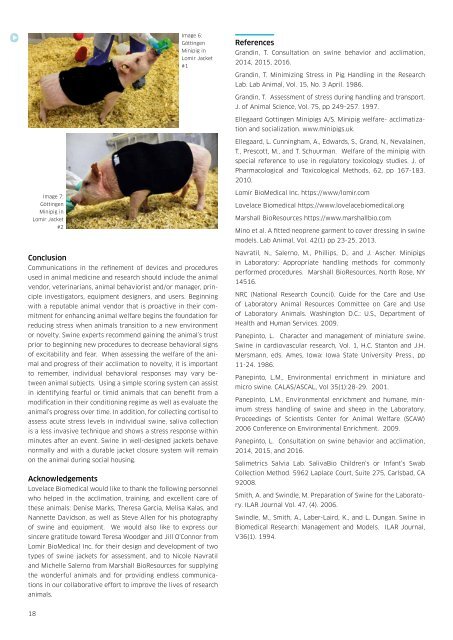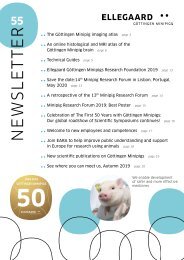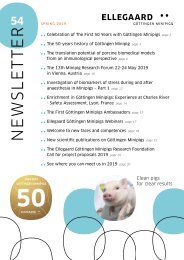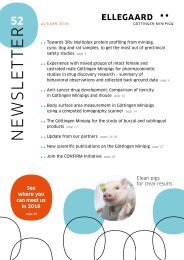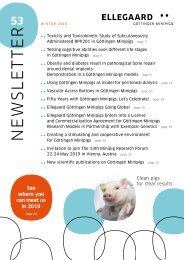Ellegaard_Minipigs_Newsletter_51
You also want an ePaper? Increase the reach of your titles
YUMPU automatically turns print PDFs into web optimized ePapers that Google loves.
Image 6:<br />
Göttingen<br />
Minipig in<br />
Lomir Jacket<br />
#1<br />
References<br />
Grandin, T. Consultation on swine behavior and acclimation,<br />
2014, 2015, 2016.<br />
Grandin, T. Minimizing Stress in Pig Handling in the Research<br />
Lab. Lab Animal, Vol. 15, No. 3 April. 1986.<br />
Grandin, T. Assessment of stress during handling and transport.<br />
J. of Animal Science, Vol. 75, pp 249-257. 1997.<br />
<strong>Ellegaard</strong> Gottingen <strong>Minipigs</strong> A/S. Minipig welfare- acclimatization<br />
and socialization. www.minipigs.uk.<br />
<strong>Ellegaard</strong>, L. Cunningham, A., Edwards, S., Grand, N., Nevalainen,<br />
T., Prescott, M., and T. Schuurman. Welfare of the minipig with<br />
special reference to use in regulatory toxicology studies. J. of<br />
Pharmacological and Toxicological Methods, 62, pp 167-183.<br />
2010.<br />
Image 7:<br />
Göttingen<br />
Minipig in<br />
Lomir Jacket<br />
#2<br />
Conclusion<br />
Communications in the refinement of devices and procedures<br />
used in animal medicine and research should include the animal<br />
vendor, veterinarians, animal behaviorist and/or manager, principle<br />
investigators, equipment designers, and users. Beginning<br />
with a reputable animal vendor that is proactive in their commitment<br />
for enhancing animal welfare begins the foundation for<br />
reducing stress when animals transition to a new environment<br />
or novelty. Swine experts recommend gaining the animal’s trust<br />
prior to beginning new procedures to decrease behavioral signs<br />
of excitability and fear. When assessing the welfare of the animal<br />
and progress of their acclimation to novelty, it is important<br />
to remember, individual behavioral responses may vary between<br />
animal subjects. Using a simple scoring system can assist<br />
in identifying fearful or timid animals that can benefit from a<br />
modification in their conditioning regime as well as evaluate the<br />
animal’s progress over time. In addition, for collecting cortisol to<br />
assess acute stress levels in individual swine, saliva collection<br />
is a less invasive technique and shows a stress response within<br />
minutes after an event. Swine in well-designed jackets behave<br />
normally and with a durable jacket closure system will remain<br />
on the animal during social housing.<br />
Acknowledgements<br />
Lovelace Biomedical would like to thank the following personnel<br />
who helped in the acclimation, training, and excellent care of<br />
these animals: Denise Marks, Theresa Garcia, Melisa Kalas, and<br />
Nannette Davidson, as well as Steve Allen for his photography<br />
of swine and equipment. We would also like to express our<br />
sincere gratitude toward Teresa Woodger and Jill O’Connor from<br />
Lomir BioMedical Inc. for their design and development of two<br />
types of swine jackets for assessment, and to Nicole Navratil<br />
and Michelle Salerno from Marshall BioResources for supplying<br />
the wonderful animals and for providing endless communications<br />
in our collaborative effort to improve the lives of research<br />
animals.<br />
Lomir BioMedical Inc. https://www/lomir.com<br />
Lovelace Biomedical https://www.lovelacebiomedical.org<br />
Marshall BioResources https://www.marshallbio.com<br />
Mino et al. A fitted neoprene garment to cover dressing in swine<br />
models. Lab Animal, Vol. 42(1) pp 23-25. 2013.<br />
Navratil, N., Salerno, M., Phillips, D., and J. Ascher. <strong>Minipigs</strong><br />
in Laboratory: Appropriate handling methods for commonly<br />
performed procedures. Marshall BioResources, North Rose, NY<br />
14<strong>51</strong>6.<br />
NRC (National Research Council). Guide for the Care and Use<br />
of Laboratory Animal Resources Committee on Care and Use<br />
of Laboratory Animals. Washington D.C.: U.S., Department of<br />
Health and Human Services. 2009.<br />
Panepinto, L. Character and management of miniature swine.<br />
Swine in cardiovascular research, Vol. 1, H.C. Stanton and J.H.<br />
Mersmann, eds. Ames, Iowa: Iowa State University Press., pp<br />
11-24. 1986.<br />
Panepinto, L.M., Environmental enrichment in miniature and<br />
micro swine. CALAS/ASCAL, Vol 35(1):28-29. 2001.<br />
Panepinto, L.M., Environmental enrichment and humane, minimum<br />
stress handling of swine and sheep in the Laboratory.<br />
Proceedings of Scientists Center for Animal Welfare (SCAW)<br />
2006 Conference on Environmental Enrichment. 2009.<br />
Panepinto, L. Consultation on swine behavior and acclimation,<br />
2014, 2015, and 2016.<br />
Salimetrics Salvia Lab. SalivaBio Children’s or Infant’s Swab<br />
Collection Method. 5962 Laplace Court, Suite 275, Carlsbad, CA<br />
92008.<br />
Smith, A. and Swindle, M. Preparation of Swine for the Laboratory.<br />
ILAR Journal Vol. 47, (4). 2006.<br />
Swindle, M., Smith, A., Laber-Laird, K., and L. Dungan. Swine in<br />
Biomedical Research: Management and Models. ILAR Journal,<br />
V36(1). 1994.<br />
18


